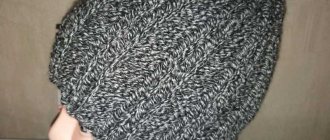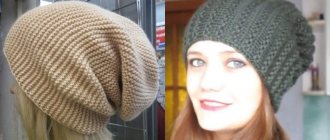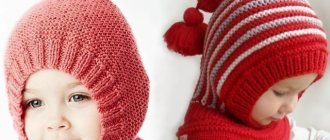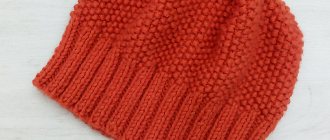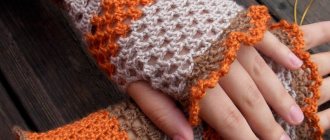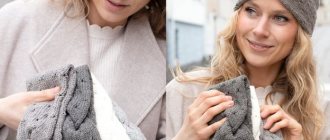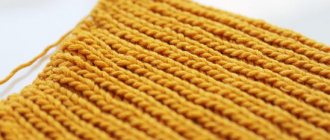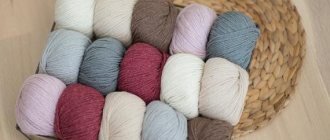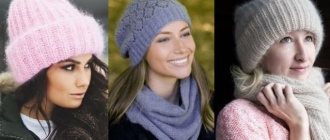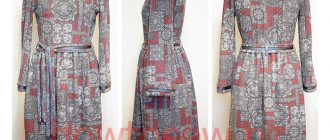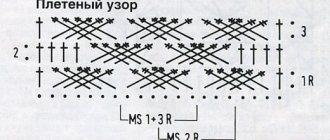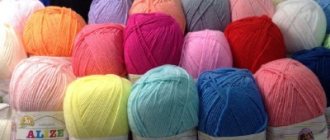A mohair hat is a stylish and very warm winter item of clothing. Buying a quality item can be difficult, so I suggest knitting it yourself. In the article I will tell you how this is done.
1 0
Is it possible to come up with a piece of clothing that is simpler and at the same time more complex than a knitted hat?! On the one hand, the thing is simple, neither in its idea nor in its execution: here are the knitting needles, here is the yarn - sit and knit. On the other hand, there is the endless torment of choosing a color, style, yarn, texture. In cases where all the options “look the same” or, conversely, you want a popular style, but at the same time “not like everyone else,” mohair attracts my attention. If adding one thin thread to the main yarn can make a familiar product more comfortable, then using only mohair in knitting will transform the hat beyond recognition.
Mohair hat with lapel with description
Mohair hats with a lapel, knitted on knitting needles, are extremely popular. Such headdresses are also called Takori. They are knitted with one lapel or two. The description and knitting pattern are absolutely the same. The only difference is the length. With one lapel, knit a height of 27-33 cm, with two - up to 35-38 cm, depending on how wide the lapel is planned.
You will need: - Nako yarn (40% mohair, 60% acrylic, 100g/500met) - 100 grams; - knitting needles No. 5. You can knit a hat with either straight or circular knitting needles, whichever is more convenient for you. On circular knitting needles the product will turn out more neat without a seam. Head volume: 54-56 cm English elastic band (even number of stitches): 1 p.: * K1, slip 1 p. with a double crochet * - repeat from * to the end of the p. 2p.: * knit a loop with a double crochet, remove the next one with a double crochet *
Hat knitting pattern:
- Cast on 64 stitches with two folds of thread and knit with an English elastic band 28-30 cm.
- Now we need to make some reductions. To do this: * knit 3 stitches together purlwise (grab the purl, knit and purl in a row), 5 stitches according to the pattern * - repeat from *. Make such decreases every 4th row, reducing the distance between decreases by 2 sts.
- When there are 12-15 stitches left on the knitting needles, transfer them to the working thread and pull them off. Firmly tighten and pull the tip inward.
Delicate openwork
We offer a new knitted mohair hat from the design studio Drops, consisting of a delicate openwork hat and a garter stitch snood.
The set is called “Lavender Sky”. Sizes: 54-56 cm and 56-58 cm, cap length 25-27 cm. Consumption: 75 grams For knitting you will need: - Drops Kid Silk strands (75% mohair, 25% silk, 200m/25g); - knitting needles on fishing line No. 3.5 and No. 2.5. Density: 23 p. = 10 cm For the openwork pattern, see diagrams A1 to A3, where all rows are indicated. How to knit an openwork mohair hat with knitting needles?
- Using a thread in two folds using knitting needles No. 2.5, cast on 124/132 sts and knit 1 p. purl (= wrong side) rows “back and forth”. Next, continue with a 2x2 rib (k2, p2) 4-5 cm high.
- Change the knitting needles to No. 3.5, remove one thread and knit 1 r. knits.p., at the same time evenly decreasing 17 p. (= 107/115 p.). Then another 1 rub. facial
- Next, distribute the loops like this: edge stitch, 8 stitches according to pattern A1, then all loops according to pattern A2, except the last 10 stitches, then 9 stitches according to pattern A3, edge stitch. Knit this way until the height of the hat is 18/19 cm (the rapport by that time should be either half or fully knitted).
- 1 row of knits.p. on the front side, decreasing 17/15 p. (=90/100 p.). Divide the knitting into sections of 9-10 stitches and mark them with 10 markers, continue with a garter stitch pattern (all stitches knit). Start making decreases every 4th row, knitting 2 stitches together after all markers (=80/90 stitches)
- When 10 stitches remain, knit them 2 together. (=5p.). Transfer them to the working thread and pull them off. Carefully sew the seam.
- For snood, on circular needles No. 4, cast on 148/168 stitches with thread in two folds (for a tight edge), then remove one thread and continue in one fold with garter stitch to a height of 35/40 cm.
Sample
You should be especially careful when working with mohair. In fact, this is one of the most difficult threads. The thing is that knitting occurs practically with your eyes closed, since the loops of the previous row will not be visible. Counting stitches is always very difficult. But there are some tips on how to do this accurately and accurately. Since counting the loops in a sample is always very important to determine the knitting density.
Set of first stitches for 2 knitting needles
Subsequence:
- cast on stitches on knitting needles;
- knit rows and, as you knit, insert a ruler (count the knitted rows at the same time), when it is 10 cm, stop knitting and write down the number of loops;
- place a ruler to the edge of the knitting needle with the last row of loops and count the number of loops in 10 cm (this is the most convenient way to count loops).
That's all the secrets regarding determining the knitting density for kid mohair.
White mohair - how soft!
Look at the photo: an airy women's knitted hat made of mohair, knitted with knitting needles. The description of knitting for this model is quite simple. When you knit from mohair, even a not very experienced knitter succeeds. The thread itself is so good that if you have small flaws, the yarn will hide everything. The hat consists of four braids, with a simple garter stitch between them.
To knit a mohair hat, prepare: - Viking Kid Mohair yarn (70% mohair, 18% merino wool, 12% polyamide, 200m/50g); - circular knitting needles No. 4.5. Density: 18 p. = 10 cm Braid pattern: 1-6p.: * 2p., 20k., 2p. * 7p.: * Purl 2, remove 10 sts on additional sp. before work, 10 knits, then 10 p. with additional sp. faces., 2 p. * 8-16 rub.: like the first rub.
Hat knitting pattern:
- Cast on 100 p., combine into a ring, knit 8 p. garter stitch (1 row knit stitch, 1 row purl stitch).
- The braid pattern tightens the knitting, so it is necessary to make additions: * 11 sts knit plaited stitches, the next 24 stitches also plaited stitches, but adding 10 stitches evenly * - repeat from * (=140 stitches). Continue with a braid pattern to a height of 22 cm.
- Forming the crown: cut 10 sts (=100 sts) on each section with braids. Then in all second r. decrease 1 point in each sector between the braids at the beginning and end of the sector from the plate.v. (=8 stitches in a row). When there are 2 stitches left in the sector, knit all stitches 2 at a time together. Then after 1 r. repeat one more time.
- Transfer the remaining loops to the working thread and pull off.
A stylish youth style for winter - this mohair hat has already been reviewed on our website TatuchkaClub.ru, we will not repeat it. Follow the link under the photo to see the diagram and description of knitting a hat on knitting needles.
Mohair beanie hat
Knitted fashion in recent years involves simple patterns combined with flowing silhouettes. This also applies to hats. The next hat model is also knitted from soft fluffy threads with mohair in a beanie style. The next style in our selection of mohair hats is a hat with a simple pattern from Drops, called Jacinta. Sizes: 56-57 cm and 57-58 cm.
You will need: - Drops Kid Silk yarn (75% mohair, 25% silk, 200m/25g); - circular knitting needles No. 3 and No. 2.5. Density: 24 p. = 10 cm
How to knit a mohair beanie hat?
- Cast on knitting needles No. 2.5 with double thread 136/144 sts and knit 1 r. knit stitch, then 4 cm ribbing pattern 2 x 2 (k2, p2).
- Change tool to No. 3 and continue knitting with one thread. Tie 1 p. persons.p., while being equal. decreasing 22/24 p. (=114/120 p.) and continue with the pattern according to the pattern 18 cm long.
- Next, knit 1 p. knits.p., decreasing 14/10 p. (= 100/110 p.).
- Place 10 markers every 10/11 stitches and continue further in garter stitch (k1, p1). In all second rows, decrease 1 stitch in front of the markers. When there are 20/30 stitches on the knitting needles, knit all the loops 2 together (=10/15 stitches).
- Transfer the remaining loops to the working thread, pull and fasten.
Scheme and pattern
You can create a pattern for making this headdress yourself or use a basic pattern. To use, you just need to adjust the pattern to your size.
There are several pattern options.
- For seamless variation and cross-cutting. With this method, the product is made in short rows;
- Knitting from bottom to top , adding and decreasing stitches.
- Wedge-shaped version.
White creative beret
Another fluffy hat made of mohair, knitted for a woman. Volumetric models are more popular than ever. Both young girls and older women wear them. You will need: - 100 grams of Laska yarn from the Trinity factory (50% mohair, 50% acrylic, 430 met/100 grams); - knitting needles No. 5.5 Decrease: - if the first stitch is a knit stitch, knit 3 stitches at a time; - if the first stitch is purl - slip three stitches onto the right sp., insert the left one into the second loop before knitting, pull the right needle out of the third and first loops, pick up the second stitch on it, return to the left sp. all three loops and knit three sts at once. behind the front walls. Density: 17 p. = 10 cm
How to make a mohair hat with your own hands
Mohair has long earned the love of needlewomen and fashion designers for its many advantages, and this season it is back in trend. You can knit anything from it - the result will always be magnificent. Yarn is made from the wool of Angora goats, which originally lived only in the Turkish province of Angora.
Their fur is distinguished by several features:
- warmth - excellent heat-retaining properties make mohair yarn one of the most popular for knitting winter clothes;
- lightness – products knitted from mohair are practically weightless;
- appearance – the thread is fluffy and has a noble, subdued shine by nature;
- subtlety – openwork and three-dimensional designs look especially impressive;
- strength is an amazing quality for such thin threads;
- elasticity - things easily return to their shape after washing or “summer hibernation”;
- moisture-absorbing properties, which is especially important when a person is sweating or for summer clothing;
- hypoallergenic;
- lends itself well to coloring.
Knitting with such threads is a pleasure. A knitted hat made of mohair with your own hands will please you for a long time with its aesthetic appearance, gives warmth and comfort. Even those who picked up knitting needles for the first time can knit such a hat. It will be warmer and lighter than knitted from sheep's wool. The following list is provided to help new recruits in the needlework camp.
- first you need to determine how easier it will be to knit - in the circle or in a straight line with subsequent stitching. It is easier for beginners to use the second option;
- Next is choosing a model. Tight-fitting, with elastic, with turn-ups. Or a mohair beret?
- choice of pattern or ornament, in the case of using two or more colors;
- Choosing knitting needles for mohair is an art. In addition to the heritage of the Soviet past, wooden knitting needles and cubes - square knitting needles with round tips - are actively used. The thickness is selected individually, experimentally, from 3 to 4.5. Thicker knitting needles will produce a loose pattern that does not hold its shape well. And an openwork hat is of little use in winter;
- Having decided on your choice, you need to knit a sample with at least 20 loops + 2 outer loops. If there are several patterns in the selected model, knit approximately ten rows of each. This will make it easier to calculate the required number of loops. With the same yarn and knitting needles, each one gets a different knitting density. That is why it is recommended to make your own sample. You may want to increase the thickness and knit in two threads;
- To calculate the required number of loops, you need to measure the head circumference and count how many loops are in ten centimeters of the sample. Further calculations using simple calculations; Example: head circumference - 55 cm, 10 cm of sample contains 20 loops. 20 x 5.5 = 110 loops.
- Having knitted the required height of the cap, it must be closed. The easiest way is to knit two loops together through one or two and thus create a pattern on a 1 x 1 elastic band. If you want to close the top smoothly, you should decrease 6-12 loops in a row . The distance between them should be the same to maintain symmetry. When 8-14 loops remain, the thread is passed through all the remaining loops, pulled together, tied in a knot and secured on the wrong side.
If you don’t want to scour the Internet looking for a suitable model and a complex pattern, you can knit a hat with an English elastic band.
When you want the hat to fit more tightly to your head, you should start with an elastic band 1 by 1 or 2 by 2. After knitting the elastic, you should either add loops or take thicker knitting needles.
The 1 x 1 rib is knitted by simply alternating knit and purl stitches. In the next row they are knitted on top of each other. If you shift this order and knit a knit stitch over the purl stitch and vice versa, you will get a pattern called “tangle” – simple, voluminous and cute.
The 2 x 2 elastic band is no more complicated than the previous one, but it tightens less. It consists of reports - two knits, two purls, repeated on top of each other.
A simpler option than the English gum is a false or fake English gum, sometimes called a snag. There is nothing wrong with this deception. Only an experienced craftswoman can distinguish an original from a fake. Since the simplified version does not contain yarn overs, double stitches or unknitted stitches, the work does not require special concentration and it is quite possible to do it while watching your favorite movie or TV series.
If you designate the front loop “V” and the purl loop “—”, then the diagram will look like this:
It is easier to control the correct execution using columns. The first column is all knits; second – knit, purl, knit, purl; third - all purl; fourth – purl, knit, purl, knit. Every report is like this.
A mohair hat knitted using this pattern will look voluminous and fluffy.
A double hat will be especially warm and not too difficult to make.
Braids are tied according to a simple pattern:
If you have imagination and minimal skills, you can come up with your own unique pattern and get a completely unique product.
Caring for a mohair hat
A knitted mohair hat requires careful handling. Hand or machine washable in “wool” or “delicate” mode. Special wool washing products or hair shampoo are suitable. Rinsing with conditioner restores softness and prevents possible tingling. Drying on heating appliances is unacceptable.
In the summer, it is advisable to use moth protection. The times of naphthalene are gone; lavender essential oil or special plates will come to the rescue. With proper care, the item will remain in its original form for more than one season.
Fashion models
Mohair hats have a beautiful look due to the good shape of the yarn. The natural composition does not cause irritation and does not leave marks on clothes. Modern designers have presented the latest models of headwear in the form of voluminous hats. They fit perfectly on the head and look great.
There are many fashionable mohair hats , decorated with various decorative elements, knitted with large knitting. Hats with lapels are very popular now, since this model is perfect not only for girls, but also for women of any age. These hats go well with coats, sheepskin coats, and down jackets.
This type of hat should have several flaps that can protect from the piercing wind. Mohair products look quite gentle and elegant, they are very practical. For this reason, many people want to purchase them. These hats are especially good for children. They are light and warm and will look great when paired with a scarf.
Fashion designers distinguish two main lines in hat fashion:
- small hats that fit tightly to the head - “beanies”;
- handmade hats that give the impression that they were knitted on antique knitting needles.
In the knitting technique, the main place is occupied by the “English rib” and simple stocking stitch. The headdress can be decorated with a beautiful pattern. Models of helmets, pipes, and hats are also popular.
Fashion trends and patterns
There are quite a few options for knitted hats. Designers offer several hats, the fashion for which has remained in recent seasons.
Hat with lapel
This is the most popular model that fits perfectly into the wardrobe of a student and a mature lady. To create, select large and small knitting. The trend is mohair hats with a lapel, knitted with a fluffy English elastic band. This is a very beautiful knitting that looks like neat rows.
Thanks to the ability to adjust the width of the lapel, a mohair hat can be considered universal. The model can be organically combined with a coat, down jacket or short fur coat. A small lapel looks more feminine; this version of the hat also fits well into a warm wardrobe.
Oversized style
Even a fashionista who has no knitting skills can create a trendy knitted hat with her own hands. The product may appear to be stretched or oversized. However, it is not. A voluminous mohair hat will give your look a charming, frivolous look. Headdresses knitted on the bias look unusual. Products made from thick threads fit perfectly into the informal style of young fashionistas. Young girls can look for things decorated with small pom-poms. Both laconic models and hats decorated with strokes of metallic paints, inscriptions or brooches are welcome.
Beanie
The model has remained in demand for many seasons. Fitted hats and elongated beanies with a lowered crown are popular. Double pieces knitted in simple stocking stitch from Italian mohair can be considered a unisex style. Hats in neutral shades (gray, black) fit stylishly into men's and women's winter wardrobes.
The elegance of a girl’s look is emphasized by products with textured decor (braids, patterns), decorated with prints, sequins, and beads. Openwork patterns combine beautifully with a knitted elastic band. Mohair beanies with pearl patterns will suit fashionistas of any age.
Berets
Even a novice craftswoman can create a fashionable beret with her own hands. It is enough to be able to knit fabric with knit/purl stitches and correctly calculate the number of loops. Experienced knitters decorate the headdress with different patterns (openwork, braids, light interlacing of stripes). Models with a small visor look interesting. It is in vain that the beret is considered an element of only the classical style. Beautiful sets of this headdress and scarf-snood are in perfect harmony with voluminous jackets, coats, and short fur coats. Products for women are knitted from mohair of any shade.
Trumpet cap
A stylish transformable headdress gives your look an unusual look. The main advantages of the model are comfort and protection from cold and piercing winds. The style of the angora hat is suitable for any style wardrobe. Openwork knitted items will emphasize the romance and femininity of the image. Things with a smooth texture, without decoration, and a tight-fitting style will fit into a sports wardrobe. Voluminous knitted hats (with braids, English elastic) will complement the winter or autumn casual style.
A set of a funnel hat and mittens or mittens looks great. It is especially comfortable in a hat, complemented by a drawstring with a cord.
Varieties of mohair
Mohair yarn came to us from Turkey. It is a wool thread with fluffy fibers. This allows you to create beautiful and warm things from it. The thickness of the threads differs depending on the type of mohair. The same thread has different thicknesses, but this is not considered a defect. Mohair happens:
- thin;
- thick;
- ultra-thin.
Any type retains heat well and absorbs moisture remarkably. The mohair composition does not cause an allergic reaction and, despite its airy structure, is a very warm material. Even with strong twisting, the composition is not damaged. Products return to their original shape after strong stretching.
Mohair dyes well, which allows you to buy yarn in a variety of colors. Its color lasts for many years, and the thread itself is very durable. This composition is safe because it goes out immediately if it catches fire.
Kid mohair is considered the most valuable of all types. It is obtained from young goats at the age of 6 months. At this time, the animals are given their first haircut and have less shine. There is also a super kid, from older kids. However, such material is used as an additive to produce expensive yarns. In adult Angora goats, the wool becomes coarser with age, but it does not lose its high qualities.
Mohair of the Gotling, Adult, MK, and Alize types is collected from older goats. They are used by many famous brands to create their collections and produce items.
Features and advantages of the material
Mohair is a wool yarn with long fluffy fibers. That is why it always produces warm and airy things.
Often mohair has different thread thicknesses, which is not a defect at all. If you are a needlewoman, then both knitting needles and a crochet hook are suitable for mohair.
Mohair is a very soft material that holds its shape well. Thus, it is suitable for knitting different types of patterns, including openwork ones.
And now a little history. Mohair was brought to us from Turkey, or more precisely, from the Angora province. It is in this area that Angora goats live, whose wool is particularly warm and soft. Of course, now goats of this breed are bred not only in Turkey, but also in North and South America.
This is one of the most luxurious natural types of wool.
This type has a natural light shine that shimmers in the sun. It fits nicely on the body and has a silky texture.
At the same time, mohair has many varieties. Each has its own advantages and features. For example, kid mohair is the most delicate of all types, goatling is the most optimal and practical, and adult mohair is the warmest.
MK, or in other words, classic mohair, is used for sewing fashionable, eye-catching items due to its fluffiness and attractive appearance. Alize is characterized by economical consumption, etc. In the next section we will look at the main types of mohair in more detail.
However, it is worth noting that mohair is hypoallergenic and is suitable even for sensitive skin . This allows even the smallest children to wear it.
Mohair is easy to care for and does not stretch or lose shape after washing. Its fibers are very dense and elastic. But you shouldn’t ignore the simple rules of caring for it.
Dressing with an English elastic band
Using an English elastic band you can get a voluminous product. This allows you to have textured and fluffy hats. This method of knitting allows you to make a warm and winter hat for the winter. The knitting pattern is so simple that a beginner with little experience can handle it.
To knit a mohair hat with a double or even triple lapel, you must have:
- mohair yarn 100−150 g;
- hook and knitting needles No. 4;
- scissors, needle.
Before you start knitting a mohair hat with an English elastic band, you need to measure the volume of your head. Depending on the thickness of the yarn, you should determine the knitting density. The future fabric should be elastic, so some errors will be hidden. Minor defects will not affect the appearance of the finished product.
For an adult, the average head circumference is 55-60 cm. From this calculation, you need to cast 78 loops, which will serve as a rim for the future headdress. You can do without it if you knit a hat with a turn-up. It should be taken into account that the 1x1 elastic band secures the edge of the product well, so special attention should be paid to it while performing the work.
According to the knitting pattern, you need to alternate stitches: knit 2 - purl 2. The border of the headdress is knitted in this sequence. When the headband is ready, you can proceed to direct knitting with an English elastic band. The 1st row is knitted, creating increases from air loops to reach 95 loops. As a result, you need to bring the height to 25 cm from the edge of the border and stop creating the pattern using a hook.
The method of alternating loops will allow you to complete the main pattern:
- Row 1 - knit stitches only;
- 2nd row - we make one edge knit and then double knits are repeated, ending the row with the front and edge;
- 3rd row - it starts with an edge loop and then it is necessary to alternate between a double and a simple straight loop, ending the row with the front and edge loops.
Further knitting is done along the 2nd and 3rd rows until the required size is obtained for the fabric of the mohair hat with two cuffs using knitting needles. After this, you need to make the top of the headdress. To do this, remove the loops in the reverse and straight rows in an even order. This makes it possible to get a tightly rounded one that can be pulled together from above.
The edge loop and the subsequent row with a grip of 3 thread arches are knitted immediately with a knit loop. The row is pumped with an edge loop. All subsequent decreasing rows should not create edge stitches.
While knitting, you must constantly monitor the tightness of the knitting. It should be loose and not tighten the loops.
The final stage of work
To give the product a finished look, you need to cut off the mohair thread, leaving a length of up to 10 cm. Open loops should be pulled together using a hook and yarn, and tie everything well. Now all that remains is to turn the hat inside out and steam it. You also need to connect the side edge loops correctly. This is done using a connecting seam.
To do this, take a regular needle with a thread that matches the color. The stitches should be made light so that the seam does not pull the hat. It should turn out elastic and soft, without losing its shape.
To knit a mohair hat, you need to have some knitting skills. Everyone can try their hand and, if desired, knit a beautiful product for themselves or their child. Such an item will be warm, fashionable and comfortable for the cold season.
Fluffy mohair (kid mohair) and knitting needles
Mohair can come in different thicknesses, and this is always indicated on the yarn package.
Accordingly, the yarn produced is different in weight and length. Different manufacturers can make balls of different lengths. This should be taken into account when choosing a product to create a hat. Knitting needles that are suitable for mohair knitting are actually no different from regular knitting needles. Therefore, all that remains is to choose the model of the knitting needles themselves and their number according to the thickness of the thread.
Most often, the manufacturer indicates on each skein the number of knitting needles that can be used to knit with this thread.
Master class: knitting a mohair hat
A mohair hat looks very gentle and feminine. Such hats never go out of fashion, and they are also very comfortable, practical to wear and suitable for any style of clothing. Today I will tell you how to knit a seamless mohair hat with a double flap.
Let's get to work. Mohair yarn contains from 25% to 70% mohair. The more mohair in the composition, the fluffier our product will be. The approximate yarn consumption for such a hat is about 100g/200m.
We cast on the loops. You need to cast on 89 stitches on the knitting needles. You can increase or decrease the number of stitches depending on how tightly or loosely you knit. The most important thing is that the number of stitches cast on is odd.
We close the knitting into a ring. To close the knitting into a ring and make the hat seamless, you need to transfer one loop from the left knitting needle to the right one. Next, put one of the loops on the second, reducing the number of loops by one. Thus, we get an even number of loops on the knitting needles, which is what is required to complete the pattern.
We knit the first row. We knit the first row with an elastic band 1*1, that is, we alternate the entire row with front and back loops. We knit the front and back loops behind the front wall.
We continue to knit the hat with an elastic band 1*1. Starting from the second row, we knit all the front loops on the front wall, and the purl loops on the back wall. So you need to knit 40 cm.
Let's make the first cut. The main fabric of the hat is knitted, which means we need to start cutting it and shaping the crown. To do this, knit a row of two loops together. We knit with facial loops behind the back wall. Out of 88 loops we get 44.
We knit the front rows. To smoothly round the hat, we knit five rows with knit stitches without changes. We knit the front loops behind the front wall.
Let's make a second cut. After we have knitted five rows with knit stitches, we knit a row with knit stitches behind the back wall, cutting two loops at a time. Since there are few stitches left, at this stage it is more convenient to switch from knitting needles on a fishing line to double needles. Out of 44 loops we get 22.
Remove the loops from the knitting needles. We cut off the working thread, leaving about 50 cm in reserve. Insert the thread into a needle with a large eye. Using a needle, remove all the loops from the knitting needles.
We form the crown and tuck in the ends. After all the loops are removed from the knitting needles, tighten the working thread tightly and make a knot. Using a crochet hook, pull the thread onto the wrong side of the hat and tuck it in.
The ends are tucked in, there’s the hat and it’s ready. Due to the double lapel, this hat is also suitable for winter. Caring for the hat is quite easy. We recommend washing it by hand using a gentle powder or mild shampoo. After washing, we recommend rinsing the hat in water with conditioner. It is better to dry the hat on a horizontal surface.
Features of mohair knitting
Mohair is made from the wool of a special breed of goats; it has long, silky pile that is pleasant to the touch. Due to the special structure of the hairs, the yarn does not roll or wrinkle when worn, and retains its volume and beautiful appearance for a long time. The products turn out to be very warm, and thanks to the fluffy structure, the thread consumption is very small.
To knit a mohair hat with two lapels you will need approximately 150 grams of yarn and knitting needles No. 3.5-4. If you need to get a warmer and more voluminous product, you can knit in two or three threads, and also take knitting needles several numbers larger. To highlight the beautiful fluffy texture, the knitting should be loose and the stitches should be loose.
How to choose
The first step is to decide on the style. Choose one that suits your face shape and accentuates your hair.
You need to decide what material you want the product from, thick and warm or thin and fluffy. After all, you will have to wear a hat in cold weather.
Mohair is often mixed with other materials. Therefore, if you come across a product that is not made from 100% mohair, do not neglect it. Mohair breaks down into individual fibers, and they try to add nylon, acrylic, wool, etc. to it.
Pay attention to the seams and how all the threads are secured. Strength and elasticity will affect the durability of your headgear.
Calculation of loops for a hat
In order for a mohair hat to fit correctly, you need to take the measurements correctly and calculate the number of loops. Each craftswoman produces a different knitting density, so it’s best to make your own calculation:
- Take a measuring tape and use it to measure the circumference of your head above the eyebrows, and then subtract 2-3 cm from the resulting figure. This is necessary so that the hat fits tightly enough and does not fall off, because the product will stretch slightly.
- Then cast on 25 stitches on the knitting needles and knit a 10 cm high sample using the selected pattern. A mohair hat knitted with a 2 x 2 elastic band looks beautiful, but you can choose any other pattern to suit your taste.
- Measure how many stitches 1 cm of knitting holds, then multiply this figure by the volume of the head, and the result will be the required number of loops for the hat.
What to wear with
Fortunately, you will not encounter any difficulties in this matter. Mohair hats go well with many things.
First of all, these are everyone's favorite fur coats. Fluffy hats will look great with fur. And they will even make it even more stylish by diluting the image with an unobtrusive accessory.
Strict winter coats are another option. You can pair it with a hat in soothing colors and a laconic design. Beret hat, hat with an English elastic band, turban, etc.
But with down jackets and various kinds of jackets you shouldn’t have any problems at all. Hats of any shade can be combined with your outerwear.
A selected set - a hat and scarf - will look very stylish. This way you will create a complete image.
How to knit a mohair hat
For example, if the volume of the head is 53 cm, and the knitting density is 2 loops per 1 cm, the calculation will be as follows:
Let's get started:
- To make a seamless mohair hat, you will need circular knitting needles. We cast on 100 loops, remove the first loop, as usual, without knitting, and then knit one row with a 2 x 2 elastic band: alternately 2 knits, and then 2 purls.
- We connect the first and last loops together, after which we continue to knit in a circle according to the pattern: we knit the front loops with the front ones, and the purl ones with the purl ones.
- We knit a fabric 40 cm long, and then start decreasing it so that the bottom of the hat turns out beautiful.
- We connect 2 knit stitches together to make one loop, and then do the same with the purl stitches. Thus, you get a 1 x 1 elastic band.
- We knit 1 row, after which we pull the thread through all the loops, pull it tightly and fasten it on the wrong side.
To get a more voluminous product, you can, as already mentioned, knit in 3-4 or even 5-6 threads, then the hat will be even warmer and suitable for even the most severe frosts. In this case, the density of the fabric will be higher, and the number of loops will decrease by 1 cm.
Knitted winter hats, the work of our readers
Spectacular winter hat knitted
A spectacular winter hat for a girl or girl! An excellent option for the currently fashionable family look format!!! Knitted with knitting needles, I used DIAMOND thread (wool + acrylic). Knitting needles - for elastic band No. 2, for the main pattern No. 3. You can knit without a seam, on
Read more…
Description of a winter hat with knitting needles made of thick yarn
Hats made of thick yarn. The yarn was used from the Pekhori factory “Souvenirnaya”. 160 meters per 200 grams. 50% wool 50% acrylic. The hats turned out dense, but at the same time soft. After washing they remained unchanged. My daughter wears one all the time. A cap
Read more…
Knitted winter hat for a girl – Tatiana’s work
Winter hat for a 1.5 year old girl made from leftover yarn. To knit this hat, I used leftover yarn, knitted it with double thread, it turned out to be a very warm and bright hat, my daughter really likes it. We measure the head circumference, determine the knitting density by knitting a small
Read more…
Winter helmet
Hello, my name is Natalya. I live in the Altai region. Our winters are harsh, so we have to imagine how to make a warm and at the same time beautiful hat for a child. For several winters now my child has been wearing helmets, this
Read more…
Knitted winter hat with ears
The work was submitted to our competition “Hats and Sets”. Author Master Svetlana. I needed: 200 g of 100% Turkish wool “BRAVO”, acrylic and circular knitting needles 40 cm long. In order to determine the knitting density, you need to knit a sample
Read more…
Women's winter hat from Tatyana Vaganova
Hat with a pattern of Royal braids. Knitted from Magnificent Pekhorka Winter yarn, 100g/300m, knitting needles No. 3 and 3.5. I dialed 122p on sleeper number 3. and the elastic band 1*1 22 rows went. I made one purl row for the fold, then
Read more…
Double-sided winter men's hat knitted
I decided to knit a hat for my dad. I found a model that would suit both of us - he prefers hats with a lapel, but I wanted aranami. The photo of the model was accompanied by a VERY INTERESTING description. The whole relish, so to speak, is that
Read more…
Knitted children's hat “Pearl Winter”
The author of this hat is Sasha’s Mom from Osinka. Since the hat is specifically for winter, it should be as warm as possible, so Sasha’s Mom chose this kind of wicker - dense and dense, but in principle you can take any other one. Loops
Read more…
Knitted children's winter hat
For a long time I was looking for a hat model on the Internet to knit a neat winter hat for a 3-year-old child with a pom-pom and ears, and I found... It’s called “I HEART CABLES”. Looks very nice on children, even boys, even
Read more…
Final processing of the product
The finished hat must be properly processed, otherwise it will look sloppy. Mohair products knitted with an elastic band must not be pressed, otherwise the fabric will become flat and lose all its beauty. Therefore, heat treatment with an iron is strictly not recommended. Lightly spray the cap with water on all sides; for this it is convenient to use a regular spray bottle. Then place the product on a small jar or vase and wait until it dries completely. As a result, the loops will be aligned, and the long pile will fluff up beautifully. You can additionally comb the product with a soft clothing brush.
A beautifully knitted mohair hat is ready! Fold the edge in two folds and you can put on the new thing. If you wish, you can wear it with one lapel, it also turns out very stylish.
